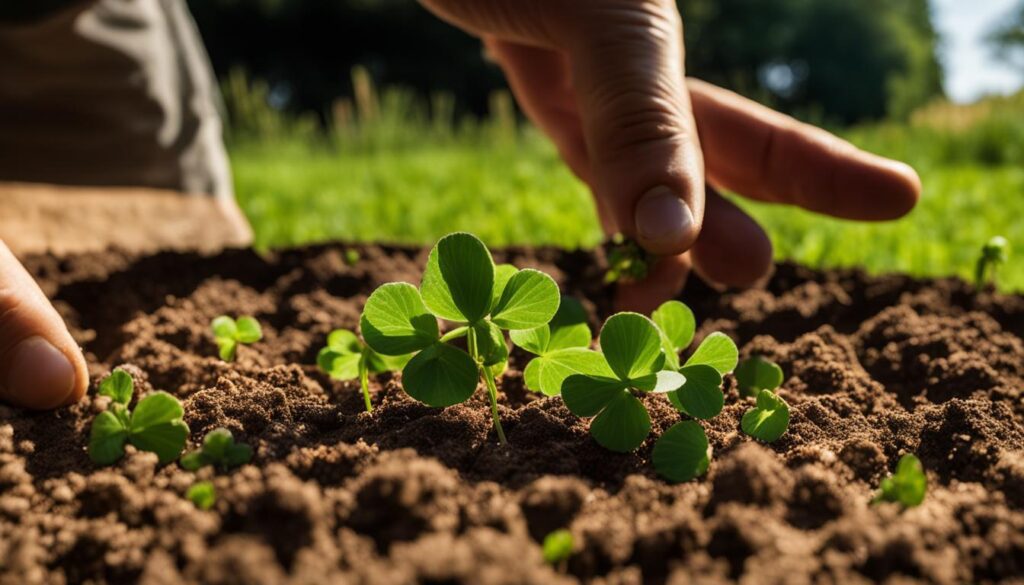Are you tired of spending countless hours and money maintaining your traditional turf grass lawn? Look no further than the eco-friendly and low-maintenance solution – the Red Clover Lawn. Red clover is a sustainable ground cover that offers numerous benefits for your outdoor space. It serves as a natural fertilizer, reduces erosion, eliminates weeds, attracts pollinators, and requires less watering and mowing. By choosing a red clover lawn, you can create a beautiful and environmentally friendly landscape. Discover more about this eco-friendly turf alternative and its advantages below.
Characteristics of Red Clover
Red clover is a versatile plant with distinct characteristics that make it an ideal choice for a low-maintenance lawn. As a cool-season perennial, red clover can also thrive as a winter annual in southern regions. Its leaves are arranged in a three-leaflet formation, featuring light green chevrons that add visual interest to the plant.
This resilient clover species spreads through stolons, which are horizontal stems that grow along the ground, and seeds, allowing it to establish a dense and healthy lawn. Red clover can reach heights ranging from 6 to 24 inches, with some varieties capable of growing up to 30 inches tall.
Hardy in USDA hardiness zones 4-8, red clover is adaptable to a wide range of growing conditions. It can thrive in areas with full sun exposure to partial shade, making it suitable for lawns with varying light conditions. While the plant prefers well-drained and loamy soil, red clover can tolerate clay soil and moderate levels of acidity.
One of the standout traits of red clover is its high shade and drought tolerance. This means that even in shaded areas or during periods of limited rainfall, red clover can remain resilient and continue to thrive. Its ability to withstand drought makes it an excellent choice for homeowners looking for a low-water lawn alternative.
When it comes to maintenance, red clover is relatively low-maintenance compared to traditional turf grass. It requires minimal watering, mowing, and fertilization, making it an eco-friendly option for those seeking a low-maintenance lawn.
Please note: While red clover has numerous advantages, it is important to be aware that it is moderately susceptible to diseases and pests, especially as it ages. Regular monitoring and appropriate preventive measures can help maintain a healthy and vibrant red clover lawn.
Growing Red Clover
Red clover is a versatile plant that primarily grows in northern and midwestern states but can also thrive in the Southeast as a winter annual. It prefers cool and moist climates but boasts better drought tolerance than other clover varieties due to its deep roots. Red clover was traditionally used as a cover crop by farmers and continues to be cultivated for hay, pasture forage, and green manure.
To successfully plant red clover in your lawn, it’s crucial to test the soil’s pH first, ensuring it falls within the optimal range of 6.0 to 7.2. This soil acidity level maximizes nutrient availability and supports the growth of red clover. Spring or late summer is the ideal time to sow the seeds.
Growing Tip: If seeding in the spring, make sure to wait until soil temperatures reach a consistent 50-65°F for optimal germination.
Once you’re ready to sow the seeds, evenly spread them over the prepared soil surface. Lightly rake the seeds into the soil to ensure good seed-to-soil contact. This step aids in seed germination and increases the chances of successful establishment. Another method to consider is frost seeding, which involves broadcasting the red clover seeds on snow-covered ground during late winter. As the snow melts, the seeds naturally settle into the soil.
For a more comprehensive lawn approach, consider using a seed mix that combines red clover with other grass varieties. This blend provides an even and healthy lawn, amplifying the benefits of both the clover and grasses.
Benefits of Red Clover
Red clover offers a wide range of benefits for both your lawn and the environment. Its vibrant and eye-catching flowers, ranging from soft rose to bright magenta, add a beautiful burst of color, enhancing the overall aesthetic appeal of your lawn.
Red clover’s taproots are thicker and longer than those of white clover, making it highly drought resistant. This means that even during dry spells, your red clover lawn will continue to thrive and maintain its lush appearance.
Another advantage of red clover is its exceptional shade tolerance. It is one of the most shade-tolerant clover varieties available, making it an excellent choice for lawns with darker areas or tree canopies. You can enjoy the benefits of a vibrant lawn in areas that receive less sunlight.
One of the remarkable properties of red clover is its strong nitrogen-fixing capabilities, surpassing those of white Dutch clover. Nitrogen-fixation refers to the process of converting atmospheric nitrogen into a form that can be taken up and used by plants. By doing so, red clover acts as a natural fertilizer, enriching the soil with nitrogen and providing essential nutrients to other grasses in your lawn.
In addition to its benefits for lawns, red clover is also valued for its medicinal properties. It has been used to treat various conditions and is widely recognized for its potential health benefits.
Representing the farms and fields of Vermont, red clover holds the honor of being the state flower. Its beauty and significance make it a fantastic choice for homeowners seeking a sustainable and visually appealing lawn.
Considerations for Clover Lawns
While clover lawns offer numerous advantages, there are important factors to consider before opting for a red clover lawn. Understanding these considerations will help you make an informed decision that aligns with your preferences and lawn maintenance goals.
Shorter lifespan: Red clover has a shorter lifespan compared to white clover, typically lasting around two years. This means you may need to reseed your lawn every couple of years to maintain its lush appearance.
Disease and pest susceptibility: Red clover is more prone to certain diseases and pests, including crown rot, root rot, anthracnose, and powdery mildew. Regular monitoring and appropriate preventive measures can help manage these issues.
Meadow-like appearance: Red clover tends to grow taller than other clover varieties, giving your lawn a charming meadow-like appearance. However, if you prefer a neater aesthetic, this aspect may not align with your vision.
Cautious mowing: When mowing a clover lawn, extra care is needed to avoid damaging or killing the clover. Set your mower deck to a higher height and mow with a sharp blade to ensure a clean cut, preserving the health of your clover plants.
Outcompeting other plants: Red clover can be vigorous and might outcompete other desired plants and grasses in your lawn. To prevent this, consider using edging or borders to establish boundaries and protect specific areas from clover dominance.
Foot traffic tolerance: Clover lawns are not suitable for heavy foot traffic. If your lawn receives frequent use or you have active children or pets, you may need to allocate alternative areas or pathways to accommodate their activities.
Allergenic potential: Be aware that clover lawns, including red clover, can attract bees due to their rich nectar production. If you or your family members have bee allergies, it is important to take appropriate precautions or consider other lawn options.
By considering these factors, you can determine if a red clover lawn is the right choice for your specific needs and preferences. Understanding the pros and cons helps you make an informed decision and create a thriving and beautiful lawn.
Popular Clover Varieties for Lawns
When it comes to choosing clover for your lawn, there are several popular varieties to consider. Each type of clover offers its own unique characteristics and benefits. Here are some of the best clover types for red clover lawns:
Dutch White Clover
Dutch white clover is the most common clover variety used in lawns. It is known for its classic clover look, with lush green leaves and abundant flowers. However, it is important to note that Dutch white clover can be aggressive and invasive in certain areas.
Microclover
Microclover is a variation of white clover with smaller leaves and fewer blooms. It is specifically bred to be more tolerant of foot traffic and mowing, making it an excellent choice for lawns with pets and children. Microclover provides all the benefits of traditional clover but with added durability.
Strawberry Clover
Strawberry clover is a lesser-known variety that offers unique qualities. It adapts well to various soil types and produces florets that resemble strawberries, adding a touch of charm to your lawn. Strawberry clover is an excellent option for those looking for a visually interesting and low-maintenance clover variety.
Red Clover
Red clover is a tender plant that grows quickly, making it a popular choice for meadows and wildflower gardens. While it is not typically used as a primary lawn clover, it can still be incorporated into your lawn to add a touch of color and diversity. Red clover pairs well with other clover varieties and grasses, creating a dynamic and vibrant lawn.
Choosing the right clover variety for your lawn depends on your personal preferences and specific lawn conditions. Consider factors such as maintenance requirements, shade tolerance, and desired visual appeal when making your selection. With the right clover variety, you can create a beautiful and eco-friendly lawn that stands out from the crowd.
Establishing a Clover Lawn
There are various methods for establishing a clover lawn. One option is to gradually add seeds to the existing lawn, allowing the clover to spread over time. Simply toss out the seeds and water them, just like you would with grass seed. Another approach is to add clover seeds during core aeration, a process that loosens the soil and enhances its fertility. By doing so, you can help the seeds establish quicker and create a healthier lawn.
If you want to create fresh areas for clover, you can dig up parts of the lawn and plant clover as a ground cover among perennials or in hard-to-grow areas. Clover can naturally grow in grass, so there’s no need to eradicate it completely. By incorporating it into your lawn, you can enjoy its many benefits while maintaining a beautiful and eco-friendly outdoor space.
By following these methods for establishing a clover lawn, you can enjoy the beauty and sustainability of clover while enhancing your existing grass. Whether you choose to gradually add seeds, incorporate clover during core aeration, or create dedicated areas for clover in your lawn, the result will be a lush, low-maintenance, and environmentally friendly outdoor space.
Is Red Clover Lawn a More Sustainable Option Than Moss for Eco-Friendly Turf?
When considering an ecofriendly lawn alternative, red clover is a more sustainable option than moss for turf. Red clover helps fix nitrogen in the soil, requires less water and maintenance, and provides a vibrant green cover. It also attracts pollinators and reduces the need for chemical fertilizers.
Conclusion
In conclusion, choosing a red clover lawn offers numerous benefits as an eco-friendly and low-maintenance alternative to traditional turf grass. Not only does it provide a visually appealing look with its vibrant pink and purple flowers, but it also contributes to overall soil health by fixing atmospheric nitrogen and acting as a natural fertilizer.
By planting a red clover lawn, you can reduce the need for harmful chemicals and excessive irrigation, making it an environmentally conscious choice. Additionally, the tall stems and dense foliage of red clover create a natural living mulch that helps control weeds and prevent soil erosion.
Furthermore, the pollinators are attracted to the vibrant flowers of red clover, promoting biodiversity in your outdoor space. While there are certain considerations such as the shorter lifespan and susceptibility to diseases and pests, these can be managed with proper care and maintenance.
Whether you choose to integrate red clover with existing grass or gradually establish it in sections of your lawn, opting for a clover lawn can create a beautiful and environmentally friendly outdoor space for you to enjoy.










